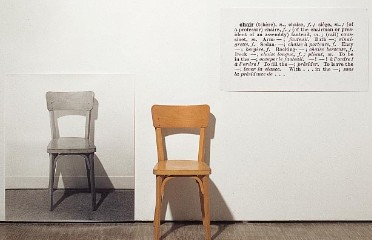
"One and Three Chairs" by Joseph Kosuth. Installation with photograph of a chair, an actual chair, and a definition of chair, 1965.
This installation, art piece, conception, work (whatever you want to call it) refers to Plato's Forms. I was an art history major and learned about this the same semester I took a philosophy class, so I got it. If you've read Plato, I'm sure you got it, too. This reminds me of Tom Wolfe's brilliant book The Painted Word where he asserts that modern art is nothing without a theory or a critic to explain it. And the whole point is not for the common man to get it, but for the elite to feel superior. It's a great read. I still love Modern Art. I love Paul Klee, Franz Kline, Brancusi, Helen Frankenthaler. Although I like talking about them, I'll pass on Frank Stella, Marcel Duchamp, and the guy who just painted a white square (I looked him up: Kasimir Malevich). Some theories are just better than others.
I like it. It's smart. It's witty and fun. But, this guy had one good idea. He's the Toni Basil or Right Said Fred of the conceptual art world.
Joseph Kosuth was a 20 year old kid when he put this together. Now he's a 60 year old man. He's gotten a good deal of attention for this piece. He has a career as a conceptual artist, and I'm sure it's an understatement to say that he makes good money.
I did a search to see what he's come up with in the last 40 years, and frankly, it's pretty boring and pretentious. There are a number of other Forms-inspired pieces (a pan, a clock, a saw, a table, a mirror) and the rest (of what I found) were mostly all "word" pieces.
There's a red neon sign that spells the word Red. Cute. There's a green neon sign that spells Five words in Green Neon. Clever. There's an oversized dictionary definition of the word art. Hmmmm. He really has me thinking now. There's a sign that asks, "What does it mean?" This is cutesy, self-conscious, conceptual art.
Kosuth wrote that his Conceptual art is based on "the understanding of the linguistic nature of all art propositions." This kind of art about art (or should I say l'art pour l'art?) is such elitist modern crap, and the funny thing is I'd probably enjoy one of his installations if I went to see it. Walking around a beautiful, spare building looking at slick little pieces would be nice. It's pretty and it's vaguely meaningful and meaningless at the same time.
Magritte's Ceci n'est pas une pipe is a similar work. This is still very modern (which usually means there is something to "get"). It's cute and witty, too. I don't think the only difference is that Magritte could paint (although it doesn't hurt), but that Magritte wasn't a one-hit wonder. I'm not a huge fan of Magritte, but he has a respectable oeuvre.

 one and three chairs
one and three chairs













































